
Summary
The poultry industry in Zimbabwe is based on both indigenous and imported poultry strains. Commercial production is dominated by imported strains and indigenous strains have remained insignificant due to lack of genetic improvement in all commercially important traits.Although the production of commercial poultry strains is ever increasing , the indigenous flocks still contribute significantly to meat and egg requirements in Zimbabwe.
As much as 20% of all poultry products eaten in Harare and adjacent towns are raised in urban environments. According to the Zimbabwe Poultry Association (ZPA) there is a huge emerging small-scale producer contribution of approximately 44,000 metric tonnes. “These producers have been able to produce broiler meat production in 2011 at an average of 6,500 chickens a month,” said ZPA.
Indigenous chicken (Road runner) chicken production systems are mostly based on the local scavenging domestic fowl (Gallus domesticus), which predominates in African villages. Sometimes the productivity of these birds is very low, but with proper management practices indigenous chicken can become very productive and has a very good potential for improving the income of the owners.
Hybrid layers
Hybrid layers are mostly kept near potential markets for eggs (such as cities and towns) where space is limited but ready made commercial feed are easily available. Layers may be kept in individual battery cages, but more often in Zimbabwe they are reared in deep litter houses where there is free movement and perches are provided.
Broilers
Broilers are heavy breeds and usually reared on deep litter floor systems. Slatted floors dispose broilers to breast blister and leg problems just as cages, leading to lower quality.
The young chicks are bought from commercial hatcheries like Hubbard , Cresta and Irvines as day old chicks, and reared in the facilities set aside.
Broilers kept for meat production, are also hybrid birds and the chicks need to be bought commercially, as farmers do not have access to the parent breeding stock. The same commercial hatcheries ( Cresta/Hubbard) listed under 'Layers' usually also have broiler chicks for sale.
Broiler hybrids are very fast growing birds and need specially manufactured feeds from reputable companies like National Foods and Profeeds. It will not work to try and rear broilers on any other feed than the specially made one from reputable companies.
Broilers can be kept in similar confinements as layers, but do not need the laying boxes. Because they grow heavy enough for slaughter in 6-8 weeks, their bones are sometimes weak. To keep them healthy and bones as strong as possible, it is good to provide exercise areas, even outside.
Chicken health and welfare
The general requirements for organic chicken raising according welfare standards include:
Poultry or poultry products must come from chickens that have been under organic management from the second day of life. If one cannot verify this they are not raising organic chickens.
All feed, except minerals and vitamins, must be organically produced. Non-synthetic vitamins are preferred, but synthetic sources are allowed if non-synthetics are not available. The following are prohibited:
i. Animal byproducts from mammals and poultry, such as meat and bone meal, may not be included in rations.
ii. Fishmeal is not permitted, because of the difficulty of determining if they were organically produced.
iii. Synthetic amino acids are not permitted.
iv. Non synthetic but non agricultural products are permitted.
The handling of feed ingredients must comply with organic requirements. Some people may buy organic feed from mills or grow their own ingredients for feed, but organic guidelines must be followed with either choice.
No drugs may be used to promote growth.
Physical alterations such as beak trimming and toe trimming are not routinely allowed, they are permitted to promote the welfare of the animal or flock. Beak trimming and toe trimming are still discouraged and would be handled on a case by case basis.
Living conditions must be established and maintained to "accommodate the health and natural behavior of animals, including access the outdoors, shade, shelter, exercise areas, fresh air, and direct sunlight."Continuous confinement in cages is not permitted, but temporary confinement is allowed if adequately justified.
Dust wallows are required, as is clean, dry bedding. Any bedding that is of a type typically consumed by poultry must meet all organicstandards.
Birds are not permitted to come into contact with treated wood used to construct chicken pens.
Health care measures must include preventive practices such as good nutrition, sanitation, healthy living conditions and vaccinations. Antibiotics are not permitted. Synthetic parasiticides including coccidiostats are not permitted. Although some natural alternative products are allowed, health problems must be controlled primarily through good management.
Birds that do become sick cannot be withheld from medical treatment just to preserve their organic status. They should be medicated and then sold into the conventional marketplace.
Chicken manure must be managed in a way that does not contribute to contamination of crops, soil, or water and that optimizes the recycling of nutrients.
Before starting up a poultry enterprise, it is important to know the market requirements for the targeted market, the investment costs, running costs, and expected revenue for the different products. In Zimbabwe markets for poultry products maybe categorized as follows:
(1) Famer to domestic trader where products are sold at the local market like Mbare or farm gate.
(2) Farmer to retailer where poultry products are sold to supermarkets and restaurants chains
(3) Farmer to leading farmer where poultry products are sold to a leading farmer like Drummond Chickens who can access markets that demand large volumes.
(4) Farmer to processor or exporter where farmers can bulk poultry products and sell to processors/packers.
(5) Contract farming (Irvines/Lunar Contracting) - direct farmer/producer group market access, where market for products is assured.
Market Trends
Consumers are shifting interest from the previously dominant hybrid layer eggs and broiler meat towards what is conceived as a healthier diet of free range or indigenous eggs/chicken. Also organic eggs and chicken find very good and well paying market especially in the major urban centres in Zimbabwe.
Broilers and layers are mainly commercially reared by urban and peri urban farmers who target the ready market. Commercial production mainly utilizes specialized hybrids of broilers and layers. Availability of chicken feed is a major challenge coupled with low quality of feeds and uncontrolled prices.
Indigenous chicken can be reared in small plots with very little investment, whereas the broilers and hybrid layers require fairly heavy investment.
The general requirements for organic chicken raising according welfare standards include:
Poultry or poultry products must come from chickens that have been under organic management from the second day of life. If one cannot verify this they are not raising organic chickens.
All feed, except minerals and vitamins, must be organically produced. Non-synthetic vitamins are preferred, but synthetic sources are allowed if non-synthetics are not available. The following are prohibited:
i. Animal byproducts from mammals and poultry, such as meat and bone meal, may not be included in rations.
ii. Fishmeal is not permitted, because of the difficulty of determining if they were organically produced.
iii. Synthetic amino acids are not permitted.
iv. Non synthetic but non agricultural products are permitted.
The handling of feed ingredients must comply with organic requirements. Some people may buy organic feed from mills or grow their own ingredients for feed, but organic guidelines must be followed with either choice.
No drugs may be used to promote growth.
Physical alterations such as beak trimming and toe trimming are not routinely allowed, they are permitted to promote the welfare of the animal or flock. Beak trimming and toe trimming are still discouraged and would be handled on a case by case basis.
Living conditions must be established and maintained to "accommodate the health and natural behavior of animals, including access the outdoors, shade, shelter, exercise areas, fresh air, and direct sunlight."Continuous confinement in cages is not permitted, but temporary confinement is allowed if adequately justified.
Dust wallows are required, as is clean, dry bedding. Any bedding that is of a type typically consumed by poultry must meet all organicstandards.
Birds are not permitted to come into contact with treated wood used to construct chicken pens.
Health care measures must include preventive practices such as good nutrition, sanitation, healthy living conditions and vaccinations. Antibiotics are not permitted. Synthetic parasiticides including coccidiostats are not permitted. Although some natural alternative products are allowed, health problems must be controlled primarily through good management.
Birds that do become sick cannot be withheld from medical treatment just to preserve their organic status. They should be medicated and then sold into the conventional marketplace.
Chicken manure must be managed in a way that does not contribute to contamination of crops, soil, or water and that optimizes the recycling of nutrients.
Points to consider before investing
Market analysisBefore starting up a poultry enterprise, it is important to know the market requirements for the targeted market, the investment costs, running costs, and expected revenue for the different products. In Zimbabwe markets for poultry products maybe categorized as follows:
(1) Famer to domestic trader where products are sold at the local market like Mbare or farm gate.
(2) Farmer to retailer where poultry products are sold to supermarkets and restaurants chains
(3) Farmer to leading farmer where poultry products are sold to a leading farmer like Drummond Chickens who can access markets that demand large volumes.
(4) Farmer to processor or exporter where farmers can bulk poultry products and sell to processors/packers.
(5) Contract farming (Irvines/Lunar Contracting) - direct farmer/producer group market access, where market for products is assured.
Market Trends
Consumers are shifting interest from the previously dominant hybrid layer eggs and broiler meat towards what is conceived as a healthier diet of free range or indigenous eggs/chicken. Also organic eggs and chicken find very good and well paying market especially in the major urban centres in Zimbabwe.
Broilers and layers are mainly commercially reared by urban and peri urban farmers who target the ready market. Commercial production mainly utilizes specialized hybrids of broilers and layers. Availability of chicken feed is a major challenge coupled with low quality of feeds and uncontrolled prices.
Indigenous chicken can be reared in small plots with very little investment, whereas the broilers and hybrid layers require fairly heavy investment.
Economic analysis and simple risk assessment
Before starting any poultry production enterprise, calculate if it is economically feasible thereby making the right decisions regarding the production system and the necessary interventions
Revenue or income
Revenue or income is all the money earned in relation to the poultry enterprise such as:
Income from sale of live birds, e.g. growers or spent hens;
Revenue or income is all the money earned in relation to the poultry enterprise such as:
Income from sale of live birds, e.g. growers or spent hens;
Income from sale of eggs;
Value of eggs or poultry eaten or given away. (Side revenues - manure, empty gunny bags etc)
Also value the standing stock, e.g. the production flock which is the foundation of future income. Poultry manure also represents a value when use on the farm or sold for other activities. As manure poultry waste reduces the cost of buying fertilizer and improves crop production.
Expenditure or costs and Risks
These are costs involved in relation to the poultry enterprise:
Points to consider before investing in a commercial poultry enterprise
1) Distance to the market for the finished products (eggs and broiler meat/live birds). This is important because transport costs money. Broiler meat requires specialized (refrigeration) transport since it is highly perishable.
2) Availability of quality feeds. Feeds alone account for 70% of the production cost in a poultry enterprise hence the need to ensure quality at an affordable price.
3) Availability of information on basic management practices and animal health services especially for vaccines and drugs.
4) Seasonal fluctuation in demands for poultry and poultry products. Demand is generally high in the month of April and December. This is associated with Easter and Christmas holidays.
5.) Optimum flock sizes so that the farmer can break even. Over 75% of all commercial poultry enterprises have flock sizes of below 300 birds. This is inefficient due to the high production cost. To break even flock sizes for broilers should be over 500 and hybrid layers 1,000.
In order to profit from any livestock enterprise, it must be remembered that we deal with fellow living creatures. There will be no profit or good returns unless we treat the animals well.
Breeds and Breeding
Zimbabwe currently has limited chicken breeds namely the hybrid layers, broilers and indigenous chicken.
Layer breeds
Value of eggs or poultry eaten or given away. (Side revenues - manure, empty gunny bags etc)
Also value the standing stock, e.g. the production flock which is the foundation of future income. Poultry manure also represents a value when use on the farm or sold for other activities. As manure poultry waste reduces the cost of buying fertilizer and improves crop production.
Expenditure or costs and Risks
These are costs involved in relation to the poultry enterprise:
- Poultry houses
- Day old chicks
- Supplementary feed, vitamins or minerals
- Vaccines and other medication
- Labour and technical advice
- Mortality (outbreak of diseases can wipe out the whole flock if not properly handled
Points to consider before investing in a commercial poultry enterprise
1) Distance to the market for the finished products (eggs and broiler meat/live birds). This is important because transport costs money. Broiler meat requires specialized (refrigeration) transport since it is highly perishable.
2) Availability of quality feeds. Feeds alone account for 70% of the production cost in a poultry enterprise hence the need to ensure quality at an affordable price.
3) Availability of information on basic management practices and animal health services especially for vaccines and drugs.
4) Seasonal fluctuation in demands for poultry and poultry products. Demand is generally high in the month of April and December. This is associated with Easter and Christmas holidays.
5.) Optimum flock sizes so that the farmer can break even. Over 75% of all commercial poultry enterprises have flock sizes of below 300 birds. This is inefficient due to the high production cost. To break even flock sizes for broilers should be over 500 and hybrid layers 1,000.
In order to profit from any livestock enterprise, it must be remembered that we deal with fellow living creatures. There will be no profit or good returns unless we treat the animals well.
Breeds and Breeding
Zimbabwe currently has limited chicken breeds namely the hybrid layers, broilers and indigenous chicken.
Layer breeds
These are chicken breeds selected for laying eggs and maybe divided into several categories:
(1) Light breeds
(1) Light breeds
Light laying breeds include the White Leghorn, Brown Leghorn and Black Minorca. The maximum adult bodyweight of light races is about 2 kg for females and 2.5 kg for cocks. The white leghorn is known to lay a large number of white eggs. It requires less feed due to its small size and is an efficient feed converter. Its low body weight allows it to withstand high temperatures better than other breeds. However, White leghorns are generally nervous and at the end of the laying period give relatively less meat than heavier breeds. For this reason the use of lighter breeds has generally changed in favour of crosses.
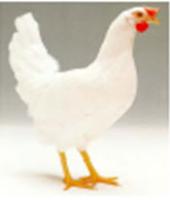
White Leghorn
(2) Medium breeds

White Leghorn
(2) Medium breeds
These are the Rhode Island Red (RIR), New Hampshire (NH) and light Sussex (LS). The RIR has dark brown feathers, lays brown eggs and is heavier but more susceptible to high temperatures than the White Leghorn. In poor conditions RIR is more viable than the light breed and has a higher carcass value. The NH has light brown feathers with similar characteristic to RIR. The LS is a white bird with black striped neck feathers and black tail.
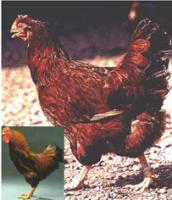
RIR
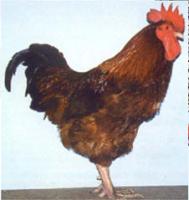
New Hampshire
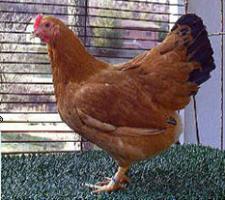
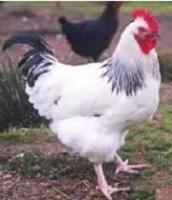
Light Sussex
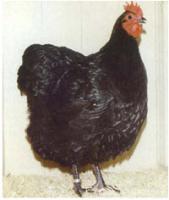
Australorp
Heavy breeds

RIR

New Hampshire


Light Sussex

Australorp
Heavy breeds
Heavy breeds include Barred and white Plymouth Rock, Buff Orpington as well as White Jersey Giant and Arbor Acres Hubbard Vantress. These breeds are used for crossing to obtain the fast growing broiler strains available from hatcheries. These are mainly the meat birds commonly referred to as broilers. Breeder stocks consist of the White Cornish (WS) and White Plymouth Rock (WPR). The White Cornish is a heavy, white feathered breed that lays brown shelled eggs. It has been developed for quality and quantity of meat. White Plymouth Rock is similar to the WS but lays more eggs.
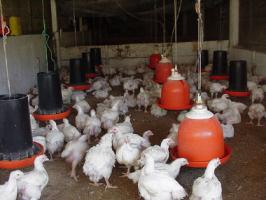
Broilers
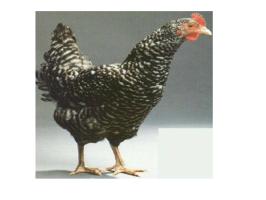
Plymouth hen
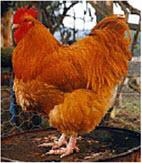
Buff Orpington
Hybrids

Broilers

Plymouth hen

Buff Orpington
Hybrids
These are crossbreds originating from breed crossing. Their performance and viability (hybrid vigour) is better than the pure breeds. Breed crossing is practised in most developing countries including Zimbabwe. Large scale poultry enterprises always use hybrids originating from line crossing due to their superior performance.
Commercial Pure and hybrid birds are produced and sold by a limited number of breeding companies to poultry farms in almost every country of the world.
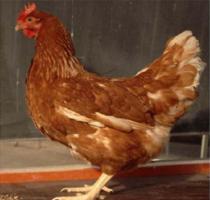
Hybrid layer
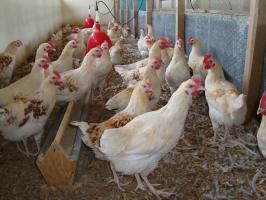
Hybrid Cockerels
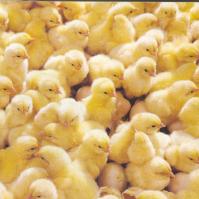
Day old hybrid chicks
Indigenous chicken breeds
Local chicken breeds are the most abundant livestock species in Zimbabwe . Indigenous chicken are mostly kept under a free range system in small flocks of less than 30 birds. They are more adapted to local conditions than the hybrids but have a lower productivity.
Below some normal features in indigenous chicken. As can be seen many of the above pure breeds features can be found among indigenous chicken, indicating a great amount of mixed genes. Breeding indigenous chicken for improvement of the breed is very feasible for the specialist.
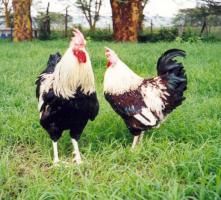
Indigenous cocks
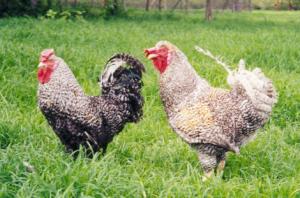
Indigenous cocks
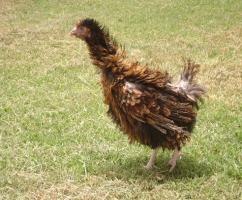
Frizzled feathered chicken
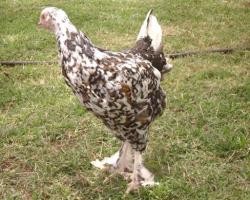
Feathered shank hen
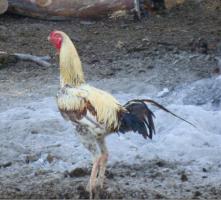
Kuchi game bird
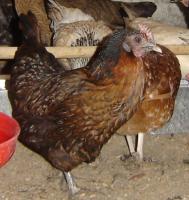
Normal feathered indigneous chicken
Commercial sources of breeding stock in Kenya
Buy day-old chicks from hatcheries such as:
Commercial Pure and hybrid birds are produced and sold by a limited number of breeding companies to poultry farms in almost every country of the world.

Hybrid layer

Hybrid Cockerels

Day old hybrid chicks
Indigenous chicken breeds
Local chicken breeds are the most abundant livestock species in Zimbabwe . Indigenous chicken are mostly kept under a free range system in small flocks of less than 30 birds. They are more adapted to local conditions than the hybrids but have a lower productivity.
Below some normal features in indigenous chicken. As can be seen many of the above pure breeds features can be found among indigenous chicken, indicating a great amount of mixed genes. Breeding indigenous chicken for improvement of the breed is very feasible for the specialist.

Indigenous cocks

Indigenous cocks

Frizzled feathered chicken

Feathered shank hen

Kuchi game bird

Normal feathered indigneous chicken
Commercial sources of breeding stock in Kenya
Buy day-old chicks from hatcheries such as:
- Irvines
- Cresta
- Hubbard (Now owned by Lunar)
Breeding
Introduce one new cock for every 10 hens every two years, in order to avoid inbreeding. Improved indigenous chickens for improving the local breeds can be bought from private breeders.
In the village setting care must be taken to protect brooding hens from predators, rodents and other forms of stress. If a brooder hen is well protected and comfortable she can easily hatch 15 eggs per sitting. A brooding cycle takes minimum 18 days after which the first eggs should start hatching. The mother will normally keep the chicks with her for a day or two before taking them to food and water. Any eggs not hatched after this will go cold and most likely not hatch. It is highly advisable to keep food and clean water available near the brooding hen during this whole period for her to hatch the maximum amount of chicks.
Selection of eggs for setting
A improved nutrition can raise the average quantity of eggs laid per clutch by 100%. For a successfull hatching, the eggs must be handled carefully from laying till setting. Eggs should be stored with the broad end facing upwards, as at this end there is an air sack, through which the egg breathes. Eggs should be stored in a clean and dried place to prevent rotting. Since fertile eggs grow slowly, eggs older than 14 days should not be used for hatching.
The reproductive cycle
By shortening the reproductive cycle, hens lay eggs earlier and double the number of clutches per hen per year. Improved management increase the survival rates of the chicks. Shortening of the reproductive cycle can be achieved by better feeding, protection form predators and rodents, timely vaccinations and deworming, control of external parasites, and culling of aggressive and unproductive birds.
Serial hatching
Introduce one new cock for every 10 hens every two years, in order to avoid inbreeding. Improved indigenous chickens for improving the local breeds can be bought from private breeders.
In the village setting care must be taken to protect brooding hens from predators, rodents and other forms of stress. If a brooder hen is well protected and comfortable she can easily hatch 15 eggs per sitting. A brooding cycle takes minimum 18 days after which the first eggs should start hatching. The mother will normally keep the chicks with her for a day or two before taking them to food and water. Any eggs not hatched after this will go cold and most likely not hatch. It is highly advisable to keep food and clean water available near the brooding hen during this whole period for her to hatch the maximum amount of chicks.
Selection of eggs for setting
A improved nutrition can raise the average quantity of eggs laid per clutch by 100%. For a successfull hatching, the eggs must be handled carefully from laying till setting. Eggs should be stored with the broad end facing upwards, as at this end there is an air sack, through which the egg breathes. Eggs should be stored in a clean and dried place to prevent rotting. Since fertile Poultry can be used to sit on eggs continuously for two or more times by removing the chicks every time they hatch and replacing them with new eggs. Ducks can sit on 30 to 35 eggs and can be used for up to six consecutive times. Combining serial hatching with syncronisation (see below), more chicks will be able to hatch without using an incubator. Turkeys are also excellent chick brooders and can raise up to 50 chicks at the time.
Brooding
In the village setting care must be taken to protect brooding hens from predators, rodents and other forms of stress. If a brooder hen is well protected and comfortable she can easily hatch 15 eggs per sitting. A brooding cycle takes minimum 18 days after which the first eggs should start hatching. The mother will normally keep the chicks with her for a day or two before taking them to food and water. Any eggs not hatched after this will go cold and most likely not hatch. It is highly advisable to keep food and clean water available near the brooding hen during this whole period for her to hatch the maximum amount of chicks.
Selection of eggs for setting
A improved nutrition can raise the average quantity of eggs laid per clutch by 100%. For a successfull hatching, the eggs must be handled carefully from laying till setting. Eggs should be stored with the broad end facing upwards, as at this end there is an air sack, through which the egg breathes. Eggs should be stored in a clean and dried place to prevent rotting. Since fertile eggs grow slowly, eggs older than 14 days should not be used for hatching.
The reproductive cycle
By shortening the reproductive cycle, hens lay eggs earlier and double the number of clutches per hen per year. Improved management increase the survival rates of the chicks. Shortening of the reproductive cycle can be achieved by better feeding, protection form predators and rodents, timely vaccinations and deworming, control of external parasites, and culling of aggressive and unproductive birds.
Serial hatching
Introduce one new cock for every 10 hens every two years, in order to avoid inbreeding. Improved indigenous chickens for improving the local breeds can be bought from private breeders.
In the village setting care must be taken to protect brooding hens from predators, rodents and other forms of stress. If a brooder hen is well protected and comfortable she can easily hatch 15 eggs per sitting. A brooding cycle takes minimum 18 days after which the first eggs should start hatching. The mother will normally keep the chicks with her for a day or two before taking them to food and water. Any eggs not hatched after this will go cold and most likely not hatch. It is highly advisable to keep food and clean water available near the brooding hen during this whole period for her to hatch the maximum amount of chicks.
Selection of eggs for setting
A improved nutrition can raise the average quantity of eggs laid per clutch by 100%. For a successfull hatching, the eggs must be handled carefully from laying till setting. Eggs should be stored with the broad end facing upwards, as at this end there is an air sack, through which the egg breathes. Eggs should be stored in a clean and dried place to prevent rotting. Since fertile Poultry can be used to sit on eggs continuously for two or more times by removing the chicks every time they hatch and replacing them with new eggs. Ducks can sit on 30 to 35 eggs and can be used for up to six consecutive times. Combining serial hatching with syncronisation (see below), more chicks will be able to hatch without using an incubator. Turkeys are also excellent chick brooders and can raise up to 50 chicks at the time.
Brooding
Before buying the young hybrid chicks, an appropriate brooding area needs to be prepared:
Day old chicks need to be kept warm at all times. As they grow and the feathers start to develop they tolerate cold better. At the same time they need to access feed and clean water at all times as they feed with short intervals.
Brooder Preparation
Use hard boards to make a brooding ring of 60 cm height
Put at least 5 cm of clean dried grass/leaves (litter) on the floor inside the brooding ring
Start with a density of 50 chicks per metre square
A hover/cover should be provided about the brooder, to reduce heat wastage
Make space for feed and water feeding equipment inside the brooder ring
Brooding of the broiler chicks is similar to that recommended for layer chicks, but the feed is different. Make sure feeds are bought as recommended.
Heat Sources
Temperatures
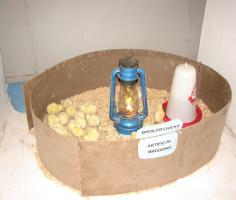
Kerosene brooder
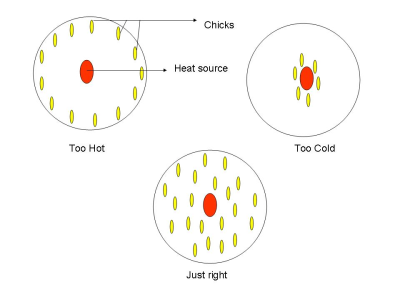
Brooding - temperature
Other Conditions
Molting
Day old chicks need to be kept warm at all times. As they grow and the feathers start to develop they tolerate cold better. At the same time they need to access feed and clean water at all times as they feed with short intervals.
Brooder Preparation
Use hard boards to make a brooding ring of 60 cm height
Put at least 5 cm of clean dried grass/leaves (litter) on the floor inside the brooding ring
Start with a density of 50 chicks per metre square
A hover/cover should be provided about the brooder, to reduce heat wastage
Make space for feed and water feeding equipment inside the brooder ring
Brooding of the broiler chicks is similar to that recommended for layer chicks, but the feed is different. Make sure feeds are bought as recommended.
Heat Sources
- Charcoal Mbaura - one is enough for 500 chicks
- Kerosene lamps - one lamp for 50 chicks
- Electricity - one infra red lamp for 250 chicks
Temperatures
- Temperature above the floor should be kept at 32° C for the first week, and then lowered by 4° C for each week up to the 4th week.
- Observe the reaction of chicks to the heat:
- At correct brooding temperatures, chicks are evenly spread within the brooder ringat
- At low temperature they crowd around the heat source
- At high temperature the chicks will move away from the heat source

Kerosene brooder

Brooding - temperature
Other Conditions
- Fresh air and light should be allowed in the brooder but no drift.
- The litter in the brooder should always be dry.
- Cleaned and disinfect brooder areas 1 to 2 weeks before bringing in new chicks.
- Beware of brooder fires. Take precautions when using charcoal Mbaura
Molting
Normally layer hens are economical to keep for about 2 years. However after about 12 months of laying, we can expect a period of resting or molting. In the natural life cycle of chickens this is the breeding period, which artificial breeding systems have not been able to remove from the lifecycle of layer hens.
Molting involves "shedding" of feathers from an otherwise healthy chicken. A molting chicken will appear more ragged than bald, as if the feathers are thinned out. Feathers will lack the normal shining appearance and appear spotty. Good producers molt fast, and normal molting times of layers should not greatly exceed 10 weeks. After this the layers can with good management come back to good production for a second year.
Culled Birds
Molting involves "shedding" of feathers from an otherwise healthy chicken. A molting chicken will appear more ragged than bald, as if the feathers are thinned out. Feathers will lack the normal shining appearance and appear spotty. Good producers molt fast, and normal molting times of layers should not greatly exceed 10 weeks. After this the layers can with good management come back to good production for a second year.
Culled Birds
Dispose all birds when proved uneconomical to keep i.e. laying below 60 % of the hen housed. Cull all sick birds and the non productive ones.
Housing
Why should poultry be housed?
Housing is necessary to protect chicken against predators, thieves, adverse weather (rain, sun, cold winds, low night temperatures) and to provide shelter for egg laying and broody hens. Suitable poultry houses are important for efficient production and management. Poultry houses and shelters vary depending on availability of materials, weather and tradition. Choice of chicken housing should be based on cost, durability and usage.
Housing
Why should poultry be housed?
Housing is necessary to protect chicken against predators, thieves, adverse weather (rain, sun, cold winds, low night temperatures) and to provide shelter for egg laying and broody hens. Suitable poultry houses are important for efficient production and management. Poultry houses and shelters vary depending on availability of materials, weather and tradition. Choice of chicken housing should be based on cost, durability and usage.
Points to consider when selecting sites for poultry housing:
- A shady, dry flat ground. Alternatively the house can be elevated from the ground.
- Trees and bushes close to the houses provide shade, windbreaks and protect birds from flying predators.
- Secure premises near the family house. It is important to hear if the chickens get disturbed at night by predators or thieves.
- Select a site on which the poultry house faces South or East in wet regions. In a rectangular house the end walls should face East and West to ensure that only the end walls face the hot afternoon sun.
Materials for building a poultry house
- Always use cheap locally available material like bamboo, wood, reeds, thatch grass or clay bricks.
- Remove the bark from the wood to reduce the parasites load. Parasite often hide beneath the bark
- Poultry houses should have windows on either side for ventilation. In addition a hole or ridge on the roof will ensure proper ventilation and give light making it easier to work in the house. Make sure winds ventilate the house without making chicken cold.
- Heat, humidity, and harmful gasses may be considerably reduced through good ventilation. High temperatures may cause deaths, a drop in egg production, low shells quality and reduced weight gain. A combination of high temperatures and high humidity may cause death in young chicks.
- Placing perches and nests inside the house to safeguard chickens against various predators. Perches and nests will also help to keep chickens and eggs clean.
- Laying nests should be place in a quiet place in the house
- To protect against diseases and parasites the house must be easy to clean. It should be big
- Make the nests and perches easy to remove when cleaning
- Houses or shelters should be sprayed with a vermicide or lime washed after cleaning to disinfect and kill parasite eggs from the walls and cracks. Place ashes on the floor and in the nests to discourage parasites.
- Clear grass and bushes for about 3 meters on all sides of the house to keep snakes and rats away
- Use wire (chicken and mesh wire) on windows to avoid predators and wild birds.
- Night houses/shelters should be built on poles, well above the ground to protect the chicken from predators such as dogs, rats and snakes.
- Build your poultry house to prevent possible injury to the birds. Remove any sharp edged objects from the house.
- For a round or square house give 1.5-2.0 m² for every 10-12 adult birds.

Acceptable housing for chicken without slatted floor
Perches are important for chickens to rest on at night. Diseases and parasites may attack poultry resting on the floor (in contact with litter). Each one-meter perch may roost five adult birds. Perches are best made of bamboo or rounded sticks and not too big or too small. Treat perches with used engine oil or kerosene to keep away parasites.
Slat NOT acceptable housing for chicken !!!

Slatted floor of a poultry house
Reason: Slats are an unnatural surface for birds to walk on and are usually free of bedding materials. However they do play an acknowledged part in maintaining the welfare of birds in the house by minimizing guano levels in high movement areas and areas subject to heavy soiling. Housing that restricts the use of slats to those areas, and is no more than 50% of the floor area, is acceptable.
Nests
When laying nests are not provided, hens lay eggs on the ground, in tall grass or in natural shelters where they may be difficult locate. Avoid building nests on the ground or outside chicken houses. Nests outside the house expose eggs to predators and thieves.
Laying nests ease egg collection and avoids eggs that are dirty and cracked. Eggs should be collected twice a daily at the same time each day (mid-morning and the evening). Removing eggs continuously is important to stop hens from going broody since broody hens stop laying.
Nests should be placed inside the chicken house and preferably above the ground.
Provide one laying nest for every 5 hens. Brooding nests are individual nests and should be placed in quiet and dark places where eggs are easily removed. Once the hen is broody it maybe necessary to remove her to an isolated place to avoid other hens disturbing her or going broody as well.
Simple nests can be made out of clay, calabashes or baskets made of local fibres, cardboard or wooden boxes. Nests should have the correct measurement for the hen to feel comfortable. An individual nest box measures 30 x 30 x 30 cm. A calabash/nest basket or nests made out of clay measure 40 x 20 x 25 cm (upper diameter x height x lower diameter).
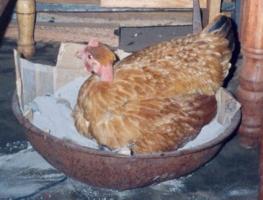
Brooding hen
Three steps when preparing an individual nest
1) Ensure the pot or basket is clean and dry
2) Fill the pot or basket with sand mixed with ashes up to 1/3 full
3) Place clean, soft nesting litter material (hay or straw or wood shaving) on top up to 2/3 full.
Nesting material should be changed at least once a week. Ensure that the nest is 1/3 full with litter material to make the hen feel secure. When necessary place ?dummy eggs? (e.g. stone eggs) in the nests to train/attract the hens into using the nests.
Mix ashes, tobacco leaves or other anti-parasitic substances with the nesting material. This will keep out most external parasites. External parasites reduce hatchability, since brooding hens spend too much time and energy leaving the nest, cleaning and scratching her body hence leaving the eggs cold.
Shelters for mother hen and chicks
Upon hatching, it is important to keep the hen and chicks close together in a shelter. Shelter should protect chicks from adult poultry; feed competition with other poultry and protect against predators. Shelters should provide a stable environment for the chicks and shelter from bad weather.
Place the shelter on a mat to protect against the cold. A shelter of basketwork with a top hole (diameter 20 cm) is useful, as feed and water may be changed without disturbing the chicks. It also gives the necessary ventilation. A woven mat on the floor may provide additional protection during cold weather. The mat should be cleaned daily to remove droppings and spilled/contaminated feed. Droppings may be recycled as farm manure
Chicken runs
Chicken runs are a fenced open air space of 25 m² or more where poultry are kept and protected against predators and thieves. Runs are also used for feeding, watering, for daily flock observation and collection of eggs. The walls are 2 meters high and can be made of clay or woven mat or chicken wire. A chicken run is relatively costly but provides security to the poultry. Allow adult birds to scavenge outside the run during daytime to reduce feeding costs.
Guide to good housing for chicken
- Use baskets for night shelter and day shelter for small chicks to reduce costs and labour involved in constructing permanent houses;
- Always use locally available materials to reduce costs;
- In permanent or semi-permanent poultry houses use slatted, raised floors to remove droppings and keep out predators;
- Always use wire netting (chicken or mesh wire) for the windows to keep out predators;
- Provide perches and nests inside the house and make them removable to facilitate cleaning;
- Ensure adequate ventilation in poultry houses without making the poultry cold;
- Provide adequate drainage incase of flooding and protect birds from the hot midday sun.
- Provide nests with clean litter which are easy to access and clean
- Always house young chicks with their mother away from adult poultry.
- Make sure that houses are easy to access and clean.
- A good housing should be spacious, well illuminated, dry and airy, easy to clean and have perches for chicken.
The main types of housing systems for hybrid layers (Egg production), differ mainly in the floor types and are the following:
Deep litter system:
Birds are reared on a floor preferably concrete to allow easy disinfection and some litter material placed 15 cm deep. Litter materials may include wood shavings, rice husks, hay, chopped up straw, crushed maize cobs and shredded paper. Allow 3 to 4 laying hens and 12-15 broilers per square metre on deep litter floor systems
Full Slatted Floor system:
Birds are reared on a raised floor made of either wooden slats or wire mesh. Slats with s width of 1.5 cm and a height of 4 cm laid 2.5 cm apart are recommended. Wire mesh usually has netting of 2.5 cm by 7.5 cm with 3 mm thickness. Allow 10 to 12 laying birds per square
Housing for Broilers
Broilers can be kept in similar confinements as layers, but do not need the laying boxes. Because they grow heavy enough for slaughter in 6-8 weeks, their bones are sometimes weak. To keep them healthy and bones as strong as possible, it is good to provide exercise areas, even outside. Also broilers like some sunshine, which reduces stress in the flock and helps keep the birds healthy.
Part free range (required for organic/ecological markets)
Both hybrid layers and broiler products improve if the chicken have access to outside exercise area, greens in the diet, sunshine and areas where they can take dust baths. Eggs from layers fed with enough greens have a deep yellow yolk, which is much preferred by the market and fetches premium prices compared to the light yellow to almost white yolks of eggs from battery hens. Broilers produce better quality meat (better texture and taste) if they have access to outdoor facilities such as sunshine, exercise, dust bath areas and green feed. They also have stronger bones and less tendency to break legs during processing.
Housing for Indigenous chicken
Poultry are often allowed to scavenge for food in the local environment during day time, getting housed in the evenings. In some cases they roost in the branches of trees or in enclosed baskets in the house to protect from predators and theft. In other cases, keepers build wooden, stone or brick accommodation attached to the family dwelling house. As brick houses tend to be difficult to keep clean. They present a potential threat due to the build-up of pathogens.
Hygiene
It is important to reduce chances of infection to a minimum. Measures for preventing disease include the following;
- Keep the chicken house clean and dry at all times
- Disinfect all litter material before use
- Locate the chicken farm at least 100m away from other chicken farms
- Keep away visitors from the chicken houses.
- Control rodents and mice
- Clean drinkers and feeders regularly
- Clean the chicken houses thoroughly and disinfect after disposing all birds
- Remove dead birds immediately
There should be adequate light in the poultry unit. The light should be enough for a person to read a newspaper at the centre of the building. Transparent roofing sheets should be fitted to improve lighting. Light in laying birds stimulates increased egg production.
Ventilation
Sunshine/Shade
Ventilation
- Poultry unit should have free flow of fresh air.
- A chimney aids the flow of air from the back to the front.
- Place 0.6 m wire-mesh opening at the back, and 1.0 m opening in front of the building. In hot areas front ventilation should be made as big as 2 metres from the top. During the cold weather cover the ventilation with curtains.
Sunshine/Shade
All creatures need some sunshine. The sun helps the birds manufacture Vitamin E. As far as possible try to provide an outdoor exercise area for the chicks to sun themselves and take dust bath during the day. This helps keep down external parasites, reduces stress and keeps the birds more resistant to diseases.
Space
Bio Security

Give clean and fresh water in a specific place
Feeds and Feeding Chicken
Why feed indigenous chicken?
Feeding is important so as to increase the production of meat and eggs from indigenous chicken. A lack of feed or water will reduce resistance to diseases and parasites, and subsequently increase flock mortality. It is important to note that even small flocks of indigenous chicken will starve during certain periods of the year (e.g drought, planting season when birds are confined, floods etc) when left to scavenge without supplementary feeding.
Egg production and growth are limited by access to feed and genetic potential. Local birds are the best converters of feed to eggs under fluctuating environmental conditions, although their production potential is much lower than genetically improved breeds.You may easily increase egg production and growth of local birds by giving supplementary feeds. Improved breeds also perform well under village conditions when given a steady supply of feeds. It is important to always start by making calculations of the cost-benefit and judge the risks involved before choosing the quantity and type of feed.
Feeds and feeding will vary between free range, semi-intensive and intensive systems of poultry production basically due to profitability. In the following we will focus on semi-intensive systems and discuss the importance of feed requirements, feed types, feed mixing, feeding equipment, feed storage, feeding and watering.
What to feed?
The composition and availability of feeds will vary, depending on the season, locality and production system. In general poultry, as other animals need feed containing energy and protein, as well as vitamins, minerals and water. The need for feed will change, depending on the age and status (chicken, grower, egg layer, broody hen) of the bird. The cheapest - and also often the best - way to supplement the diet of your poultry, is to use local resources. However, many vitamins and nutrients are destroyed if stored too long or under sub-optimal conditions, e.g. high humidity and heat. Knowledge of feed quality and sources of different feed types is important for feed safety.
If your production is based on improved breeds or hybrids for egg production, different types of commercial diets may be offered. These are divided into three distinct categories, with decreasing amount of protein as follows;
A starter diet or (chick mash): high in protein; offered from day old up to 8 weeks; Each chick will consume 2 kg during this period
A growers' diet/mash: medium in protein; offered from 9 weeks up to 18 weeks; Each grower will consume about 8 kg during this period
A layer diet/mash: lower in protein; offered to hens from 19 to 75 weeks. Allow 120 g of feed per bird per day. Hens consume about 45 kg of feed annually
Note: The above quantities are a guide and will vary depending on feed quality and level of feed wastage.
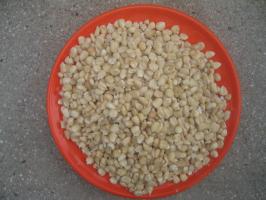
Maize for energy
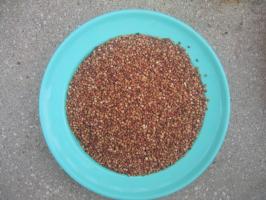
Sorghum for energy
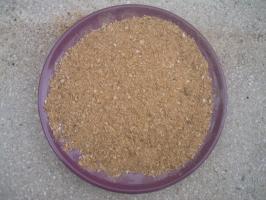
Fish meal for protein (Kapenta/Matemba)
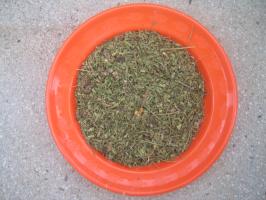
Leucaena leaves for protein and vitamin
When buying commercial feeds, calculate whether it is profitable based on the market price for eggs or meat/live birds. If the product price is lower than the price of feed consumed by the birds it is not economical to offer commercial feeds. Indigenous chicks may be offered commercial diets profitably from day old to six weeks of age.
Space
- Too many birds kept together may cannibalise/wound or even kill each other, as the stronger ones peck the weaker.
- Do not keep local breeds in confinement without free access to outdoor areas. Also hybrid chicken do better with acces to outside runs.
- Provide a space of 5 square meters per adult bird in a run system.
- When space is limited, diseases are passed more easily from one bird to another.
Bio Security
- Do not allow visitors or vehicles into the poultry farm unless thoroughly disinfected
- Use foot baths with disinfectant outside each poultry house
- Wear protective clothing for each house
- Do not allow wild birds and other fowls into the poultry house or farm
- Burn and bury dead birds
- Do not mix birds of various ages

Give clean and fresh water in a specific place
Feeds and Feeding Chicken
- Supplementary feeding in particular for small chicks, is one of the most important means of preventing diseases.
- Store Feeds in a dry and clean place always to avoid contamination and spread of diseases.
- Provide your poultry with clean water daily to avoid the spread of waterborne diseases, such as Fowl Cholera. Daily addition of EM to drinking water has been shown to help prevent diseases.
Why feed indigenous chicken?
Feeding is important so as to increase the production of meat and eggs from indigenous chicken. A lack of feed or water will reduce resistance to diseases and parasites, and subsequently increase flock mortality. It is important to note that even small flocks of indigenous chicken will starve during certain periods of the year (e.g drought, planting season when birds are confined, floods etc) when left to scavenge without supplementary feeding.
Egg production and growth are limited by access to feed and genetic potential. Local birds are the best converters of feed to eggs under fluctuating environmental conditions, although their production potential is much lower than genetically improved breeds.You may easily increase egg production and growth of local birds by giving supplementary feeds. Improved breeds also perform well under village conditions when given a steady supply of feeds. It is important to always start by making calculations of the cost-benefit and judge the risks involved before choosing the quantity and type of feed.
Feeds and feeding will vary between free range, semi-intensive and intensive systems of poultry production basically due to profitability. In the following we will focus on semi-intensive systems and discuss the importance of feed requirements, feed types, feed mixing, feeding equipment, feed storage, feeding and watering.
What to feed?
The composition and availability of feeds will vary, depending on the season, locality and production system. In general poultry, as other animals need feed containing energy and protein, as well as vitamins, minerals and water. The need for feed will change, depending on the age and status (chicken, grower, egg layer, broody hen) of the bird. The cheapest - and also often the best - way to supplement the diet of your poultry, is to use local resources. However, many vitamins and nutrients are destroyed if stored too long or under sub-optimal conditions, e.g. high humidity and heat. Knowledge of feed quality and sources of different feed types is important for feed safety.
If your production is based on improved breeds or hybrids for egg production, different types of commercial diets may be offered. These are divided into three distinct categories, with decreasing amount of protein as follows;
A starter diet or (chick mash): high in protein; offered from day old up to 8 weeks; Each chick will consume 2 kg during this period
A growers' diet/mash: medium in protein; offered from 9 weeks up to 18 weeks; Each grower will consume about 8 kg during this period
A layer diet/mash: lower in protein; offered to hens from 19 to 75 weeks. Allow 120 g of feed per bird per day. Hens consume about 45 kg of feed annually
Note: The above quantities are a guide and will vary depending on feed quality and level of feed wastage.

Maize for energy

Sorghum for energy

Fish meal for protein (Kapenta/Matemba)

Leucaena leaves for protein and vitamin
When buying commercial feeds, calculate whether it is profitable based on the market price for eggs or meat/live birds. If the product price is lower than the price of feed consumed by the birds it is not economical to offer commercial feeds. Indigenous chicks may be offered commercial diets profitably from day old to six weeks of age.
Scavenging
In a free-range or semi-intensive poultry rearing system, adult hens and cocks ought to be given enough time and space for scavenging in the surroundings daily. The best time for scavenging is early morning and late afternoon when there are plenty of insects and less heat. Chicks below six weeks of age should be confined. Supplementary feeds should be offered in the morning and evening when the birds come back for the night.Ad libitum clean water should be provided in shady areas during the day to avoid heat stress.
In a free-range or semi-intensive poultry rearing system, adult hens and cocks ought to be given enough time and space for scavenging in the surroundings daily. The best time for scavenging is early morning and late afternoon when there are plenty of insects and less heat. Chicks below six weeks of age should be confined. Supplementary feeds should be offered in the morning and evening when the birds come back for the night.Ad libitum clean water should be provided in shady areas during the day to avoid heat stress.
Note; Always give free access to water.
Simple ration for supplementing local chicks from day-old to 8 weeks (total 930 g)
Ingredient Quantity
1) Crushed maize/sorghum or millet 1 kg tin
2) Wheat/sorghum or millet bran 1 kg tin
3) Sunflower/sesame/groundnut cake 2 match boxes
4) Bonemeal/salt mix 1 match boxes
5) Sesbania/leucaena leaves 2 match boxes
Examples of home made rations
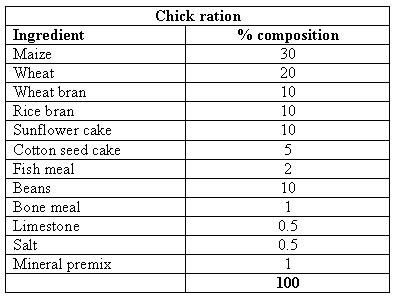
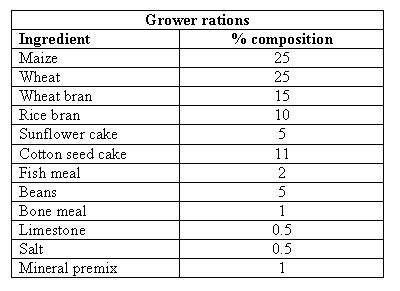
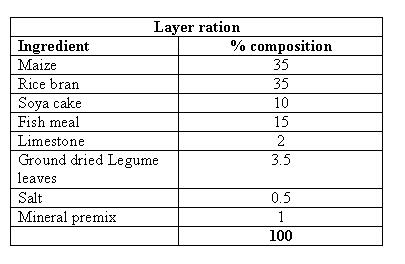
How much to feed?
A major economic advantage of the free-range or semi-intensive production systems over the intensive systems is the ability of poultry to scavenge for in the surroundings. This so-called scavenging feed resource base (SFRB) will change over the seasons based on climate, geography and production system in the area on which the poultry scavenge for feeds. Depending on the season, the chicken may find nearly all they need in the surroundings (e.g. during harvest) or nothing (during lean season).
Simple ration for supplementing local chicks from day-old to 8 weeks (total 930 g)
Ingredient Quantity
1) Crushed maize/sorghum or millet 1 kg tin
2) Wheat/sorghum or millet bran 1 kg tin
3) Sunflower/sesame/groundnut cake 2 match boxes
4) Bonemeal/salt mix 1 match boxes
5) Sesbania/leucaena leaves 2 match boxes
Examples of home made rations



How much to feed?
A major economic advantage of the free-range or semi-intensive production systems over the intensive systems is the ability of poultry to scavenge for in the surroundings. This so-called scavenging feed resource base (SFRB) will change over the seasons based on climate, geography and production system in the area on which the poultry scavenge for feeds. Depending on the season, the chicken may find nearly all they need in the surroundings (e.g. during harvest) or nothing (during lean season).
Amount of feed at different ages of local poultry
Age (wks) Intake/bird/day (g dry weight)
1 week 12 - 15
2weeks 15 - 21
3 weeks 21 - 35
4 - 6 weeks 35 - 50
7 - 8 weeks 55 - 60
16 - 27 weeks 68 - 80
28 weeks 100
Limit the quantity of feed offered to the birds daily to at least 30% - 50% of their full daily intake. Allow a maximum of 30 - 40 g/bird/day from week 4 - 6 and gradually reducing the supplementary feeding. At day old to 4 weeks young chicks will receive feed according to their needs. As the birds grow, they will gradually get a smaller portion of what they need, until they only get between 1/3 and half of their needs as adults. Economic benefits are calculating the break-even point from the sale of eggs and live birds relative to the cost of disease control, housing, labour and feeds.
To ensure sustained egg and meat production, offer feeds on a continuous basis rather than large quantities during the harvest season and none during the lean season. Reduce the flock size when feed costs are high rather than reducing the amount of feed given to each bird.
How to feed?
It is important to use simple local measures to administer feeds. By using a table, you can calculate how much feed to use. Fig. shows calculated daily feed requirements based on a flock of 1 cock, 4 hens and 15 three week old chicks.
Simple calculation for daily feed requirements
1 cock: 35 g. = 35
4 hens: 4 x 35 g. = 140
15 chicks: 15 x 25 g. = 375
Total = at least 550 g per day
When using 1 kg containers (or a cup) measure the amount of feed the container holds, and then calculate the number of containers of feed needed daily. If the container holds 750 g of feed you will need to fill the container ¾ full. To keep the birds hungry for scavenging, offer half the feed in the morning, which will be equal to a half full container. To avoid competition, feed give the young chicks a little more than half in a separate shelter. Feed the hens next and finally before the feeder is empty feed the cock. When cocks are offered feed before the other birds, they over eat and leave less feed for the rest of the flock. Cocks are better at scavenging within the surrounding than the rest of the birds. Young chicks will need relatively more protein in their diet than adult birds hence the need to mix two different rations for young and adult birds, respectively.
1 cock: 35 g. = 35
4 hens: 4 x 35 g. = 140
15 chicks: 15 x 25 g. = 375
Total = at least 550 g per day
When using 1 kg containers (or a cup) measure the amount of feed the container holds, and then calculate the number of containers of feed needed daily. If the container holds 750 g of feed you will need to fill the container ¾ full. To keep the birds hungry for scavenging, offer half the feed in the morning, which will be equal to a half full container. To avoid competition, feed give the young chicks a little more than half in a separate shelter. Feed the hens next and finally before the feeder is empty feed the cock. When cocks are offered feed before the other birds, they over eat and leave less feed for the rest of the flock. Cocks are better at scavenging within the surrounding than the rest of the birds. Young chicks will need relatively more protein in their diet than adult birds hence the need to mix two different rations for young and adult birds, respectively.
Feed stuff Problems
- Fish meal can give a fishy taste to meat and eggs and is not allowed in organic farming. Can contain excessive amounts of salt.
- Cassava tubers contain cyanide, which is toxic, and the tubers must be sliced and dried in the sun before feeding.
- Oil seed cakes can contain excessive amounts of oil and fibre, which lower digestibility of the feed.
- Beans and peas contain a number of anti-nutritional components and should be dried in the sun or cooked for a short period (chick pea and pigeon pea are exceptions and can be fed raw after crushing)
Feeders and drinkers are similar across the production systems. Feeders and drinkers should always be kept clean to prevent the spread of diseases. They should be big enough for all birds of the same age to feed at the same time. One metre trough or a 35 cm (diameter) tube feeder is big enough for 20 adult birds to eat and for 40 to drink. Feeders and drinkers may easily be produced out of local materials. An empty tin placed upside down on a plate forms a drinker. By keeping the tin upside down the water is not contaminated with dirt. Make two small holes near the rim diagonal to each other. Pour clean water in the can. Put a flat plate with a small rim on top and turn the can and plate upside down, while pressing them against each other. Gently place the drinker on the ground. The rim of the plate should be low enough for young chicks to drink, but also high enough for adult birds to dip their wattles to keep them cool during the hot weather. Usually several waterers in different sizes should be used. Ensure that feeders minimize feed wastage. Feed wastage can be minimized when feeders are not filled to the top. Fill the feeders half full and check them regularly for refills.
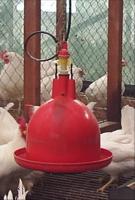
Automatic drinker
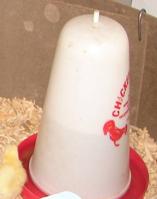
Chick drinker
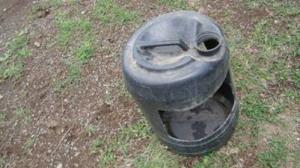
Home made poultry drinker
Guide to feed management
Before buying, mixing, and storing feeds, it is important to understand some underlying principles of good feed management.It is crucial to:
1) Use local feed ingredients for local birds;
2) Know the quality or feed value and prices of each feed ingredient;
3) Buy missing feed ingredients, such as vitamins or protein sources locally from a stockist;
4) Change the feed formulation depending on availability, quality or feed value and price;
5) Reduce the flock size under free-range production system during lean seasons and when feed cost increases;
6) When changing feeds always do it slowly and gradually;
7) Mix feed ingredients uniformly in relatively small quantities to avoid long storage periods;
8) Use locally available materials such as tins or matchboxes for quantifying the different ingredients to be mixed. Grams or percentages do not work in practice;
9) Store mixed feed or feed ingredients separately on a platform approx. 30 cm above the floor;
10) Stop the entry of rats, pigeons, or other type of birds into the feed store;
11) Make sufficient ventilation to ensure that feed ingredients are not wet due to humidity;
12) Caution; Do not use feed ingredients that are mouldy, discoloured or infested with pests.
Water
Scavenging poultry can get diseases by drinking water from small ponds or puddles, as these can transfer water borne diseases and parasites. Poultry should get clean and fresh water all the time at the same place. This makes it is easy to medicate them.
Clean water should be given at least early in the morning and again in the evening when the birds are returning to the house for the night. It is important that all feeders and drinkers are kept clean to avoid disease infection through dirty feed and water.

Other feed stuffs
Algae and water plants material have been considered appropriate for feeding poultry since they provide carotenoids and other fat-soluble vitamins.The carotenoids improve the colour of the egg yolks and together with vitamin E enhance the egg quality and the viability of the hatchlings. The deeper the egg yolk colour and pigmentation, the greater is the supply with vitamin A to the consumer.
Where available, the mixing of dried molasses with protein feeds have been shown to improve nutritional status of chicken.
Dung heaps from the waste of cattle, goats and sheep are excellent sources of insect protein but also may act as sources of parasites (e.g. coccidia) and other diseases.
Feeding Hybrid layers
Hybrid layers have quite easy feeding regimes, as the feed they need is manufactured and can be ready bought. However if you want to have nice yellow eggs also greens need to be provided. This can be any kind of edible green plants such as vegetable waste, grass, legumes etc. Preferably the greens should be hung up in a string so the birds have to jump a bit to reach them. This gives both good exercise and avoids too much mess to clean up later. Without greens the yolks of the eggs will not have as much colour.
1) Use local feed ingredients for local birds;
2) Know the quality or feed value and prices of each feed ingredient;
3) Buy missing feed ingredients, such as vitamins or protein sources locally from a stockist;
4) Change the feed formulation depending on availability, quality or feed value and price;
5) Reduce the flock size under free-range production system during lean seasons and when feed cost increases;
6) When changing feeds always do it slowly and gradually;
7) Mix feed ingredients uniformly in relatively small quantities to avoid long storage periods;
8) Use locally available materials such as tins or matchboxes for quantifying the different ingredients to be mixed. Grams or percentages do not work in practice;
9) Store mixed feed or feed ingredients separately on a platform approx. 30 cm above the floor;
10) Stop the entry of rats, pigeons, or other type of birds into the feed store;
11) Make sufficient ventilation to ensure that feed ingredients are not wet due to humidity;
12) Caution; Do not use feed ingredients that are mouldy, discoloured or infested with pests.
Water
Scavenging poultry can get diseases by drinking water from small ponds or puddles, as these can transfer water borne diseases and parasites. Poultry should get clean and fresh water all the time at the same place. This makes it is easy to medicate them.
Clean water should be given at least early in the morning and again in the evening when the birds are returning to the house for the night. It is important that all feeders and drinkers are kept clean to avoid disease infection through dirty feed and water.

Other feed stuffs
Algae and water plants material have been considered appropriate for feeding poultry since they provide carotenoids and other fat-soluble vitamins.The carotenoids improve the colour of the egg yolks and together with vitamin E enhance the egg quality and the viability of the hatchlings. The deeper the egg yolk colour and pigmentation, the greater is the supply with vitamin A to the consumer.
Where available, the mixing of dried molasses with protein feeds have been shown to improve nutritional status of chicken.
Dung heaps from the waste of cattle, goats and sheep are excellent sources of insect protein but also may act as sources of parasites (e.g. coccidia) and other diseases.
Feeding Hybrid layers
Hybrid layers have quite easy feeding regimes, as the feed they need is manufactured and can be ready bought. However if you want to have nice yellow eggs also greens need to be provided. This can be any kind of edible green plants such as vegetable waste, grass, legumes etc. Preferably the greens should be hung up in a string so the birds have to jump a bit to reach them. This gives both good exercise and avoids too much mess to clean up later. Without greens the yolks of the eggs will not have as much colour.
Feed intake of laying hens depends on the quality of the feed, the body weight, its performance and environment. The following standards maybe used as a guide when feeding birds on a layers mash (2800 kcal ME)
1) 2 kg body weight (for maintenance) 65g
2) For each 100g difference in body weight 2.5g
3) For each gram of egg weight 1g
4) For each degree deviating from 20 degree Celsius 1.5g
Thus, if the average weight of the layer bird is 1.8 Kg, with a daily egg weight of 56 g and temperatures of 24 degree Celsius (normal room temperature), the feed required will be as follows;
1) 1.8 kg hen ..................................... 65 - (2 x 2.5 g) = +60 g
2) 56 g egg weight............................... = +56 g
3) 24 degree Celsius ........................... 110 g

Hybrid layers have quite easy feeding regimes, as the feed they need is commercial available. Where the market demands a golden yellow egg yolk, the birds need to be provided with a scavenging area in a free range environment or provided with green leaves or vegetables wastes such as grass, Lucerne or kales. Yolk colour maybe influenced by the genotype and the rate of egg production but feed composition is the major influencing factor. Both natural and synthetic sources of pigmenting egg yolks are in use commercially. Feeds stabilized with antioxidants such as vitamin E and A improve yolk colour pigmentation.
Feeding broilers
Along with their recommended broiler feed, the birds also highly appreciate additions of greens for pecking and absorption of higher amounts of vitamins. AIM: Production of big broiler capons of 2 kg live weight (1.5 kg dressed weight at 6 - 8 weeks) In order to reach this aim a feed needs to contain the following:
2) 56 g egg weight............................... = +56 g
3) 24 degree Celsius ........................... 110 g

Hybrid layers have quite easy feeding regimes, as the feed they need is commercial available. Where the market demands a golden yellow egg yolk, the birds need to be provided with a scavenging area in a free range environment or provided with green leaves or vegetables wastes such as grass, Lucerne or kales. Yolk colour maybe influenced by the genotype and the rate of egg production but feed composition is the major influencing factor. Both natural and synthetic sources of pigmenting egg yolks are in use commercially. Feeds stabilized with antioxidants such as vitamin E and A improve yolk colour pigmentation.
Feeding broilers
Along with their recommended broiler feed, the birds also highly appreciate additions of greens for pecking and absorption of higher amounts of vitamins. AIM: Production of big broiler capons of 2 kg live weight (1.5 kg dressed weight at 6 - 8 weeks) In order to reach this aim a feed needs to contain the following:
Feed for the first 4 weeks (broiler starter):
- Crude protein content greater than 22%
- Crude fiber less than 6%
- High energy content as close to 3000 kcal/kg as possible
Each broiler chick takes 1.2 kg of this starter mix during this period.
Feed for week 4-8 (Broiler finisher):
Feed for week 4-8 (Broiler finisher):
- Crude protein content greater than 18%
- Crude fiber less than 7%
- Energy content as close to 3000 kcal/kg as possible
Each broiler chick consumes about 3.5 kg of this mixture during this phase.
Chicken diseases
Chicken diseases - What causes diseases?
Characteristics of healthy birds:
Characteristics of unhealthy birds/sick birds
Chicken diseases
Chicken diseases - What causes diseases?
- Microorganisms
- Parasites (Internal and external)
- Malnutrition
- Injuries
- Chemical (eg. Sodium chloride poisoning).
Characteristics of healthy birds:
- Alert and on guard.
- Bright eyes and comb.
- Walk, run, stand and scratch.
- Continuously eat and drink.
- Normally lay eggs.
- Normally smooth and neat feathers.
- Soft compact droppings breathe quietly.
Characteristics of unhealthy birds/sick birds
- Tired and lifeless
- Dull eyes and comb
- Sit or lie down
- Eat and drink less
- Lay less or stop laying eggs
- Ruffled and loose feathers
- Wet droppings with blood or worms, diarrhea
- Cough, sneeze and breathe noisily.
Health and disease management
-Notify veterinarian as soon as possible.
- Starts at the hatchery and continue to maturity.
- Poultry well fed and managed and effectively vaccinated against known diseases usually remain healthy.
- In case of disease outbreak, sick birds should be isolated and dead birds removed burnt or buried:
-Notify veterinarian as soon as possible.
Rules for disease prevention
Symptoms: Bone deformation and feather loss. The birds walk with difficulty; they limp. Legs are deformed. Some deficiencies may cause feather loss. Treatment, if detected in time: Supplementary vitamins and calcium, fresh grass, and cow dung. Nutritional diseases may be avoided when the birds have access to normal vegetation and are therefore rare in scavenging chickens.
1) Protozoan diseases
- Vaccinate the chicken as recommended by the vet
- Give access to the right feed and clean water, in particular for small chicks
- Build shelters against wind and rain and predators
- Clean houses regularly and apply lime wash/disinfect the floor and walls
- Provide dry litter regularly where applicable
- Do not put too many birds together
- Different species of poultry for example hens, turkeys, pigeons, ducks and guinea fowls should be kept separate
- Separate chicks from adult birds except from the mother hen
- Vaccinate chicks against the most important diseases and revaccinate if necessary
- Isolate and treat sick birds. If medication is not available then kill the sick birds
- Burn or burry killed birds (do not try to eat sick birds that have been killed - diseases can sometimes transfer to human beings never mind how well they are cooked).
Symptoms: Bone deformation and feather loss. The birds walk with difficulty; they limp. Legs are deformed. Some deficiencies may cause feather loss. Treatment, if detected in time: Supplementary vitamins and calcium, fresh grass, and cow dung. Nutritional diseases may be avoided when the birds have access to normal vegetation and are therefore rare in scavenging chickens.
1) Protozoan diseases
Protozoa such as Emiria tenella (coccidia) are larger than bacteria and can be easily seen under the microscope. Protozoan diseases are caused by poor hygiene and sanitation. Symptoms: Sick looking birds with head down, ruffled feathers and bloody diarrhea, death of young chicks.
Prevention and control:
- Avoid keeping different age groups of birds in the same house as disease may spread from adults to young chicks
- Use of EM or BM in drinking water for prevention
- Clean up chicken house and disinfect the area with lime (dusting with whitewash or agricultural lime)
- During outbreaks use coccidiostat mixture in drinking water
2) Bacterial diseases
Bacteria are minute germs that can only be seen under microscopes. Bacterial diseases can be prevented through good hygiene and sanitation. Very common are diseases caused by Salmonella bacteria, namely:
Pullorum disease. It is caused by sub-species S. pullorum and it is severe by chicks. It is transmitted from hen to chicks during egg formation, contamination of eggs during laying or the chicksget infected form faeces.
Symptoms: dead embryo in eggs that do not hatch; chicks develop wet tails within the first week; whitish diarrhoea, chicks walk with difficulty, show big bellies and drag their wings, huddling anddifficulty in breathing. Mortality can reach 100% in the first two weeks.
Fowl typhoid. It is caused by the species S. gallinarum and it affects growers and adult chickens. It is spread through contamination of feed and water by faeces of infected birds.
Symptoms: Usually seen in older birds, high body temperature, tiredness, blue comb, decrease in egg production, egg fertility and hatchability; anorexia and dullness followed by sudden death.
Salmonellosis. It is caused by another Salmonella species. It affects chicks and adults.It is spread by contamination of eggs at laying or through contaminated feed and water and faeces.
Symptoms: Decline in egg production, egg fertility and hatchability; anorexia and dullness followed by sudden death.
Collibacillosis. It is acute in chicks and chronic in adult chicken. Common in newly hatched chicks. Chicks get contaminated through eggs and contaminated faeces, while feed and water transmit the disease to both chicks and adults. It can be prevented by keeping good egg and nest sanitation.
Symptoms: Respiratory distress, diarrhoea, high mortality of chicks and dead embryos in spoiled eggs.
Infectious Coryza. This disease can be acute, mild or chronic. Contamination occurs by faecal matter, aerosols or through feed and water. It can be prevented by vaccination with bacterin in water at 10 to 12 weeks and 16 to 18 weeks.
Symptoms: Swollen watery eyes, closed eyes, nasal discharge (runny nose), laboured breathing and decrease in egg production. All clinically ill chicken should be destroyed.
Fowl Cholera (Pasteurellosis). This may occur at all ages of chicken, causing infection of the stomach region.
Symptoms: severe diarrhea, breathing problems, loss of appetite, blue combs and wattles. May occur as a cronic disease or as sudden death. Infection is mainly through contaminated feed and drinking water. There is no treatment. Best prevention is strict hygiene and vaccination. Destroy through killing and burn affected birds.
Pullorum disease. It is caused by sub-species S. pullorum and it is severe by chicks. It is transmitted from hen to chicks during egg formation, contamination of eggs during laying or the chicksget infected form faeces.
Symptoms: dead embryo in eggs that do not hatch; chicks develop wet tails within the first week; whitish diarrhoea, chicks walk with difficulty, show big bellies and drag their wings, huddling anddifficulty in breathing. Mortality can reach 100% in the first two weeks.
Fowl typhoid. It is caused by the species S. gallinarum and it affects growers and adult chickens. It is spread through contamination of feed and water by faeces of infected birds.
Symptoms: Usually seen in older birds, high body temperature, tiredness, blue comb, decrease in egg production, egg fertility and hatchability; anorexia and dullness followed by sudden death.
Salmonellosis. It is caused by another Salmonella species. It affects chicks and adults.It is spread by contamination of eggs at laying or through contaminated feed and water and faeces.
Symptoms: Decline in egg production, egg fertility and hatchability; anorexia and dullness followed by sudden death.
Collibacillosis. It is acute in chicks and chronic in adult chicken. Common in newly hatched chicks. Chicks get contaminated through eggs and contaminated faeces, while feed and water transmit the disease to both chicks and adults. It can be prevented by keeping good egg and nest sanitation.
Symptoms: Respiratory distress, diarrhoea, high mortality of chicks and dead embryos in spoiled eggs.
Infectious Coryza. This disease can be acute, mild or chronic. Contamination occurs by faecal matter, aerosols or through feed and water. It can be prevented by vaccination with bacterin in water at 10 to 12 weeks and 16 to 18 weeks.
Symptoms: Swollen watery eyes, closed eyes, nasal discharge (runny nose), laboured breathing and decrease in egg production. All clinically ill chicken should be destroyed.
Fowl Cholera (Pasteurellosis). This may occur at all ages of chicken, causing infection of the stomach region.
Symptoms: severe diarrhea, breathing problems, loss of appetite, blue combs and wattles. May occur as a cronic disease or as sudden death. Infection is mainly through contaminated feed and drinking water. There is no treatment. Best prevention is strict hygiene and vaccination. Destroy through killing and burn affected birds.
Prevention and control
Salmonella and other pathogenic bacteria are present in the air and feaces of most animals, and can even be present in some of the food items bought in the shops. Bacterial diseases can be prevented through good hygiene and sanitation. Which means regular cleaning of chicken houses and runs, regular disinfections with lime, etc. Some diseases such as fowl typhoid can be prevented by vaccinating the birds.
Note: Do not vaccinate sick birds.
3) Parasitic diseases
Parasites are organisms that live in or on a host (animal or plant); the parasite obtains nourishment from the host without benefiting or killing the host. Chicken parasites include lice and fleas, and worms living in the opening of organs. They may cause diseases and weaken the immune-system, making the chicken susceptible to other diseases.
Salmonella and other pathogenic bacteria are present in the air and feaces of most animals, and can even be present in some of the food items bought in the shops. Bacterial diseases can be prevented through good hygiene and sanitation. Which means regular cleaning of chicken houses and runs, regular disinfections with lime, etc. Some diseases such as fowl typhoid can be prevented by vaccinating the birds.
Note: Do not vaccinate sick birds.
3) Parasitic diseases
Parasites are organisms that live in or on a host (animal or plant); the parasite obtains nourishment from the host without benefiting or killing the host. Chicken parasites include lice and fleas, and worms living in the opening of organs. They may cause diseases and weaken the immune-system, making the chicken susceptible to other diseases.
Worms
Worms inhabit the alimentary canal and other internal organs such as lungs, trachea, etc. There are two groups of worms: round worms and flat worms.
Round worms
Ascridia galli. They infect both chicks and adult chicken. Infection occurs through eggs that are laid by female worms in birds' entestines and are passed out in droppings. They mature in one week or longer, and are swallowed up by chicken, hatch and cause new infection. Prevention is difficult due to feeding habits, especially by scavenging chicken.
Symptoms: Slow growth and stunted, culled feathers and drooping head, thirst, low egg production and death due to intestinal obstruction in young birds.
Round worms
Ascridia galli. They infect both chicks and adult chicken. Infection occurs through eggs that are laid by female worms in birds' entestines and are passed out in droppings. They mature in one week or longer, and are swallowed up by chicken, hatch and cause new infection. Prevention is difficult due to feeding habits, especially by scavenging chicken.
Symptoms: Slow growth and stunted, culled feathers and drooping head, thirst, low egg production and death due to intestinal obstruction in young birds.
Gape worms (Syngamus treachea). They infect the trachea (windpipe) of chicken. Adult worms live and lay eggs in the birds trachea; the eggs get coughed out or get swallowed into the oesophagus and discarded via faeces. The eggs hatch to larvae which infect chicken or enter intermediate hosts such as beetles and earthworms.
Symptoms: Difficulty in breathing and gasping for air (thus the term gapeworm), huddling, and death fue to suffocation.
Symptoms: Difficulty in breathing and gasping for air (thus the term gapeworm), huddling, and death fue to suffocation.
Flat worms
Tape worm (Raillietina tetragona) infests scavenging chicken. The worms release the eggs free or retained in a segment. Beetles and snails ingest the eggs. The eggs develop in these intermediate hosts infecting chicken that feed on them. Prevention occurs by using clean containers.
Symptoms: Stunting, Thirst, poor health, low egg production and death of young birds on poor diets.
Prevention and cure
Intestinal worms in chicken are controlled by regular deworming with recommended deworming medicine usually mixed with drinking water.
External parasites
The most common external parasites include lice, mites, fleas and ticks. They infest poultry houses and breed in cracks of the buildings. Infestation occurs through infected birds and pets, and affect all ages of birds but are severe in chicks.
Prevention can be done by maintaining cleaniliness of the poultry nests and houses and sealing cracks in the walls and on the floors.
Lice can be seen around eyes and nose. They lay eggs on the feathers and suck blood from chicken, causing discomfort.
Mites live in cracks in the poultry houses, not on the host. They suck blood from the birds at night and remain in the cracks during the day. In severe infections, birds become anaemic. Fleas can be seen on the belly. They suck blood from birds after which they drop and lay eggs in the litter. The eggs mature to adult fleas, which can survive for up to a month without feeding. Attacks all ages any time, but occurs more frequently in humid chicken houses with bad hygiene. Adult birds are clearly disturbed and spend a lot of time pecking and polishing feathers. Young chicks may die from anemia. If not treated, mites, lice, fleas, ticks will cause weight loss and possibly loss of feathers due to the parasites sucking blood and to skin irritation
Treatment: Spray or dust with pesticides, ashes, and oil. Ashes and sulphur powder may be used where the hens do dust bathing. Nests may be protected by putting a few tobacco leaves mixed with ashes in the nests.
Tape worm (Raillietina tetragona) infests scavenging chicken. The worms release the eggs free or retained in a segment. Beetles and snails ingest the eggs. The eggs develop in these intermediate hosts infecting chicken that feed on them. Prevention occurs by using clean containers.
Symptoms: Stunting, Thirst, poor health, low egg production and death of young birds on poor diets.
Prevention and cure
Intestinal worms in chicken are controlled by regular deworming with recommended deworming medicine usually mixed with drinking water.
External parasites
The most common external parasites include lice, mites, fleas and ticks. They infest poultry houses and breed in cracks of the buildings. Infestation occurs through infected birds and pets, and affect all ages of birds but are severe in chicks.
Prevention can be done by maintaining cleaniliness of the poultry nests and houses and sealing cracks in the walls and on the floors.
Lice can be seen around eyes and nose. They lay eggs on the feathers and suck blood from chicken, causing discomfort.
Mites live in cracks in the poultry houses, not on the host. They suck blood from the birds at night and remain in the cracks during the day. In severe infections, birds become anaemic. Fleas can be seen on the belly. They suck blood from birds after which they drop and lay eggs in the litter. The eggs mature to adult fleas, which can survive for up to a month without feeding. Attacks all ages any time, but occurs more frequently in humid chicken houses with bad hygiene. Adult birds are clearly disturbed and spend a lot of time pecking and polishing feathers. Young chicks may die from anemia. If not treated, mites, lice, fleas, ticks will cause weight loss and possibly loss of feathers due to the parasites sucking blood and to skin irritation
Treatment: Spray or dust with pesticides, ashes, and oil. Ashes and sulphur powder may be used where the hens do dust bathing. Nests may be protected by putting a few tobacco leaves mixed with ashes in the nests.
External parasites (behaviour and parasites) Scaly legs
Scaly leg is caused by an external parasite irritating the skin on the birds' legs. Symptoms: Legs clearly have scales and wounds and may become crippled in their appearance. Treatment: Dip the legs daily in kerosene, oil or in an insecticide until the scales disappear.
4) Viral diseases
Scaly leg is caused by an external parasite irritating the skin on the birds' legs. Symptoms: Legs clearly have scales and wounds and may become crippled in their appearance. Treatment: Dip the legs daily in kerosene, oil or in an insecticide until the scales disappear.
4) Viral diseases
Viruses can be prevented by vaccination. They are the smallest germs and can cause incurable diseases. There is no treatment for virus diseases.
Newcastle disease
Newcaste is the most economically important and the only notifiable disease in chicken. Often 30-80% of the flock dies. It is spread by dogs, birds, wild birds and man. Prevention occurs only by early vaccination.
Symptoms: Respiratory stress, lack of appetite, green diarrhoea, nervous symptoms and high mortality. Death can also be sudden without symptoms.
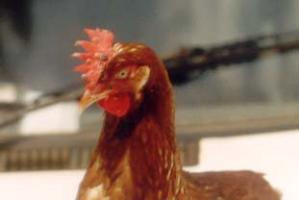
A hen with fowl pox pimples on the comb
Fowl Pox
Fowl pox is a chronic disease in adult birds and deadly among chicks and growers. It is caused by Pox virus and is transmitted by mosquito bites and mechanically through broken skin. Prevention occurs by clearing bushes.
Symptoms: Pimples or scabs on the birds combs, wattle and eyelids, high body temperature a watery discharge from eyes, difficulty in breathing indicated by whizzing sound and loss of appetite, tiredness followed by sudden death.
Infectious bronchitis
This is a contagious disease, acute in chicks and chronic in adult birds. Transmission occurs through faeces from sick birds, contamination of litter and by air.
Symptoms: Sneezing, watery eyes, nasal discharge, wet droppings, poor egg shell with no death unless from secondary infection. Chicks gasp and cough, breath noisily, have watery eyes and nostrils, become depressed and huddle. Mortality can be as high as 25%.
Avian Influenza (Fowl plague)
This is an acute disease in chicken, turkeys, ducks and wild birds. The disease is found naturally in ducks and other waterfowl, and may spread as a highly contagious and potentially dangerous form to chickens. Infects through contaminated feed and drinking water from ponds. Transmission occurs through contaminated faeces, water and air.
Symptoms: Respiratory distress, sneezing, swollen head and face, emaciation and nervous disorder. High flock mortality, blue and swollen comb and wattles, Infected birds must be destroyed and location of infection quarantined. Always call a veterinarian if you suspect AI. Do not eat infected birds.
Infectious Bursa Disease (Gumboro)
This disease is common in hatcheries. It affects young chicken 2 to 6 weeks old and it is rare in indigenous birds. Transmission occurs through feed, water and faeces.
Symptoms: Diarrhoea, sleepiness and depression, ruffled feathers and trembling of the head. Mortality is between 50% and 80%. The disease weakens the immun-system, making the birds more susceptible to other infections. It can be controlled by vaccinating the chicken when they are 2 to 6 weeks old though drinking water.
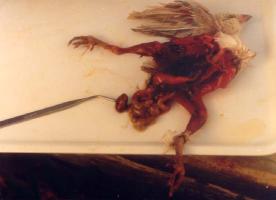
Death caused by infectious bursa disease.
Marek's disease
Seen only in birds older than 16 weeks. Initially the birds may show paralysis of one or both wings. Or one or both legs might be paralysed. The disease is a virus, so there is no treatment, but commercial vaccines are available.
Mycotoxicosis (fungal poisoning)
Symptoms: Weakness, pale combs. Treatment: Supplementary vitamins. Prevention: Proper storage of feed to prevent growth of the fungiproducing mycotoxins, the cause of the disease.
Vaccination methods
Newcastle disease
Newcaste is the most economically important and the only notifiable disease in chicken. Often 30-80% of the flock dies. It is spread by dogs, birds, wild birds and man. Prevention occurs only by early vaccination.
Symptoms: Respiratory stress, lack of appetite, green diarrhoea, nervous symptoms and high mortality. Death can also be sudden without symptoms.

A hen with fowl pox pimples on the comb
Fowl Pox
Fowl pox is a chronic disease in adult birds and deadly among chicks and growers. It is caused by Pox virus and is transmitted by mosquito bites and mechanically through broken skin. Prevention occurs by clearing bushes.
Symptoms: Pimples or scabs on the birds combs, wattle and eyelids, high body temperature a watery discharge from eyes, difficulty in breathing indicated by whizzing sound and loss of appetite, tiredness followed by sudden death.
Infectious bronchitis
This is a contagious disease, acute in chicks and chronic in adult birds. Transmission occurs through faeces from sick birds, contamination of litter and by air.
Symptoms: Sneezing, watery eyes, nasal discharge, wet droppings, poor egg shell with no death unless from secondary infection. Chicks gasp and cough, breath noisily, have watery eyes and nostrils, become depressed and huddle. Mortality can be as high as 25%.
Avian Influenza (Fowl plague)
This is an acute disease in chicken, turkeys, ducks and wild birds. The disease is found naturally in ducks and other waterfowl, and may spread as a highly contagious and potentially dangerous form to chickens. Infects through contaminated feed and drinking water from ponds. Transmission occurs through contaminated faeces, water and air.
Symptoms: Respiratory distress, sneezing, swollen head and face, emaciation and nervous disorder. High flock mortality, blue and swollen comb and wattles, Infected birds must be destroyed and location of infection quarantined. Always call a veterinarian if you suspect AI. Do not eat infected birds.
Infectious Bursa Disease (Gumboro)
This disease is common in hatcheries. It affects young chicken 2 to 6 weeks old and it is rare in indigenous birds. Transmission occurs through feed, water and faeces.
Symptoms: Diarrhoea, sleepiness and depression, ruffled feathers and trembling of the head. Mortality is between 50% and 80%. The disease weakens the immun-system, making the birds more susceptible to other infections. It can be controlled by vaccinating the chicken when they are 2 to 6 weeks old though drinking water.

Death caused by infectious bursa disease.
Marek's disease
Seen only in birds older than 16 weeks. Initially the birds may show paralysis of one or both wings. Or one or both legs might be paralysed. The disease is a virus, so there is no treatment, but commercial vaccines are available.
Mycotoxicosis (fungal poisoning)
Symptoms: Weakness, pale combs. Treatment: Supplementary vitamins. Prevention: Proper storage of feed to prevent growth of the fungiproducing mycotoxins, the cause of the disease.
Vaccination methods
There are four fundamental ways of vaccinating birds:
1) Eye drops
2) Injections
3) Skin piercing.
4) Orally (in feed or water)
For scavenging poultry, you should avoid mixing vaccines with drinking water or feed, as it is difficult to give the right dose. Research has shown that protection against e.g. Newcastle disease is highly variable if vaccine is given through water or feed. Giving the right dose is essential for the vaccine to work properly. A too high dose of a live vaccine may kill a young chick, whereas a too low dose will not give adequate protection. Thus, it is important to consult a veterinarian or auxiliary veterinarians (barefoot vets, village vaccinators) for further advice before carrying out a vaccination.
1) Eye drops
2) Injections
3) Skin piercing.
4) Orally (in feed or water)
For scavenging poultry, you should avoid mixing vaccines with drinking water or feed, as it is difficult to give the right dose. Research has shown that protection against e.g. Newcastle disease is highly variable if vaccine is given through water or feed. Giving the right dose is essential for the vaccine to work properly. A too high dose of a live vaccine may kill a young chick, whereas a too low dose will not give adequate protection. Thus, it is important to consult a veterinarian or auxiliary veterinarians (barefoot vets, village vaccinators) for further advice before carrying out a vaccination.
Tools for application normally include a clean apron (green or other dark colour if possible) vaccine vial (B) stored in a cool box (C), soap to clean hands (D), clean needles (E), clean syringe (G) and a clean box for needles and syringe (F). Needles and syringe should be boiled in water for 5 minutes and cooled before re-use
It is important to treat the clean syringe and needle carefully. Do no touch the end of the needle after cleaning. Put the needle gently on the syringe holding the needle with the sharp end upwards . Put the vaccine vial upside-down and press the needle gently through the plastic seal of the vial cap. Pull the syringe handle gently down, while sucking the vaccine out of the vial until the syringe is full. Press the syringe handle back until you reach the right volume.
Ensure that there are no air bubbles trapped in the syringe or the needle. Air bubbles will give the wrong dose to the chickens. Normally a full 1 ml syringe will match 10 doses, one for each of ten adult birds. This however depends on the weight of the bird and the type of vaccine, and the application method.
The most common methods for vaccinating adult poultry are eye drops (A), injections in the breast or thigh muscles (B) or by piercing the skin of the wing (C). The most common methods for young chicks are eye drops and skin piercing. When the birds grow older, injections are given in the breast or thigh muscles. Depending on the vaccine type, eye drops may also be used for adult birds. Please consult the local veterinarian for clarification and technical information
The most common methods for vaccinating adult poultry are eye drops (A), injections in the breast or thigh muscles (B) or by piercing the skin of the wing (C). The most common methods for young chicks are eye drops and skin piercing. When the birds grow older, injections are given in the breast or thigh muscles. Depending on the vaccine type, eye drops may also be used for adult birds. Please consult the local veterinarian for clarification and technical information
Vaccines should be given either early morning, before letting the birds out of the chicken house or when the local birds are easy to catch resting in the trees. When vaccinating adult poultry for the first time, you should preferably be two persons, one holding the bird, the other one vaccinating.
General precautions for vaccination with live vaccines:
General precautions for vaccination with live vaccines:
- All vaccines should be stored in a refrigerator before use.
- Some vaccines are heat stable, which means that the vaccine will tolerate high temperatures. However, heat stable vaccines should also be stored in a cold place to keep them viable. You should always keep vaccines out of direct sunlight.
- When using vaccines in the field, you should as far as possible transport them in a cool box with ice.
- The syringe, needle and other equipment to be used for vaccination should not be cleaned by any chemical disinfectants, as these may destroy the vaccine. They should instead be disinfected in boiling water and be used after cooling.
- The vaccines must be mixed or diluted in cold distilled water, and care must be taken to ensure that the vaccines do not come in contact with direct sunlight.
- It is best to vaccinate birds during the cool hours of the day, either in the morning or evening.
- Some mixed vaccines should be used within 30 minutes. Otherwise they will be useless and should be thrown away.
- Always consult a veterinarian or an auxiliary veterinarian before conducting a vaccination campaign.
Chicken Products and Marketing
Poultry play an important role improving the income of local population and providing high-quality protein (meat and eggs). It is important to know the market requirements, the investment costs, running costs, and expected revenue for the different products before starting any production activity.
Hence the need to carry out a detailed market study including a cost and benefit analysis, before choosing the system of production. Start with a production based on local breeds, local feeds and local demands before proceeding into a more sophisticated production system with improved breeds whose products require a stable market. In general the economic outcome as well as the necessary investments and risk involved in the production, will vary from one system to the other e.g A free range production system will have relatively low risks compare to an intensively managed systems (higher risk).
Commercialization
Live birds and fertile eggs are sold in village markets while hybrid table eggs are more often found in peri-urban and urban areas or along traffic corridors, where confined production systems can be managed. At village markets live birds are sold at highly variable prices depending on factors such as demand (high during festivals), size and weight, plumage and colour. Cocks are usually highly priced at most markets compared to hens. In certain regions e.g western Kenya indigenous chicken are also highly priced compared to exotic breeds irrespective of size. Likewise eggs from indigenous chicken are often more valued than table eggs from exotic hens, despite their smaller size. The taste and texture of meat and eggs from indigenous chicken are a major reason for the higher prices
Marketing
Birds for sale
Cockerels in a flock should be sold as soon as they attain the correct weight for the market. At the age of 6 months and a weight of approximately 1.5 kg, cocks are usually big enough for sale in prime markets. Retain a breeding cock for every 10 - 15 hens in the flock. Breeding cocks should be sold when mating is inefficient (low fertility/hatchability). Care should be taken not to return live birds from the market back to the farm due to disease. Old hens which are out of laying should also be sold. Restrain birds for sale in the night or attract them with feed then hold them using a piece of metal wire bent at the end.
Birds for sale
Cockerels in a flock should be sold as soon as they attain the correct weight for the market. At the age of 6 months and a weight of approximately 1.5 kg, cocks are usually big enough for sale in prime markets. Retain a breeding cock for every 10 - 15 hens in the flock. Breeding cocks should be sold when mating is inefficient (low fertility/hatchability). Care should be taken not to return live birds from the market back to the farm due to disease. Old hens which are out of laying should also be sold. Restrain birds for sale in the night or attract them with feed then hold them using a piece of metal wire bent at the end.
Production and sale of eggs
Egg production starts at 20 - 24 weeks of age depending on genetic and environmental factor such as light and nutrition. After the onset of lay, peak production is attained within 6 to 10 weeks. During this stage the rate of lay will be greater than 80 to 90 % (hens laying an egg daily). This level of egg production will continue and then gradually decline until it is uneconomical to keep the hens.
Hens will lay eggs is sequences (clutches) of 1 - 30+ eggs each separated by a single or more pause days. The first egg of a clutch is laid early in the morning and the following eggs laid later on successive days because the time interval between successive eggs is longer than 24 hours with an average of 25 hours. A hybrid layer will produce 250 - 300 eggs per laying cycle.
Egg production starts at 20 - 24 weeks of age depending on genetic and environmental factor such as light and nutrition. After the onset of lay, peak production is attained within 6 to 10 weeks. During this stage the rate of lay will be greater than 80 to 90 % (hens laying an egg daily). This level of egg production will continue and then gradually decline until it is uneconomical to keep the hens.
Hens will lay eggs is sequences (clutches) of 1 - 30+ eggs each separated by a single or more pause days. The first egg of a clutch is laid early in the morning and the following eggs laid later on successive days because the time interval between successive eggs is longer than 24 hours with an average of 25 hours. A hybrid layer will produce 250 - 300 eggs per laying cycle.
Handling Eggs
Eggs should be collected and sold while fresh, particularly when cooling is not practiced. Collect eggs from the laying boxes at least once, but rather two times a day, and store them in a dark, cool place. Eggs should normally not be cleaned. When the eggs are dirty, clean them with a dry sponge or cloth and sell them immediately. Cleaning eggs with water often destroys the shells natural protection against infection.
Pack eggs in boxes, egg trays or other suitable containers to avoid breakage. Sell eggs in the market two to three times a week so as to create a name for selling fresh eggs. If profitable, grade your eggs according to size. Always keep records of your production and sale as explained under Record Keeping (verlinken mit Datasheet Record Keeping).
Manure
Litter in the poultry house should be kept dry and removed regularly to reduce the load of parasite. Chicken manure contains the highest amount of Nitrogen of any livestock manure. It is therefore very valuable as fertilizer, but if applied fresh to crops can also burn these crops. The best way of utilizing chicken manure is to compost it along with any plant material found around the farm.
- Collect eggs 2 to 3 times a day.
- Separate broken and dirty eggs from whole eggs.
- Place eggs with the broad end up in the egg tray.
- Store eggs in a cool dry place and Do not stack more than six trays.
Eggs should be collected and sold while fresh, particularly when cooling is not practiced. Collect eggs from the laying boxes at least once, but rather two times a day, and store them in a dark, cool place. Eggs should normally not be cleaned. When the eggs are dirty, clean them with a dry sponge or cloth and sell them immediately. Cleaning eggs with water often destroys the shells natural protection against infection.
Pack eggs in boxes, egg trays or other suitable containers to avoid breakage. Sell eggs in the market two to three times a week so as to create a name for selling fresh eggs. If profitable, grade your eggs according to size. Always keep records of your production and sale as explained under Record Keeping (verlinken mit Datasheet Record Keeping).
Manure
Litter in the poultry house should be kept dry and removed regularly to reduce the load of parasite. Chicken manure contains the highest amount of Nitrogen of any livestock manure. It is therefore very valuable as fertilizer, but if applied fresh to crops can also burn these crops. The best way of utilizing chicken manure is to compost it along with any plant material found around the farm.
Uses of litter

Poultry manure
Quantify manure yield
Chicken manure can be used in fish ponds. The manure is partly eaten by the fish while the rest is used by plants to grow and then eaten by fish. Dried poultry manure maybe used to feed ruminants (cattle and goats) in combination with grains and molasses. A biogas digester can be used to make gas from the manure. The slurry left over may also be used as fertilizer for use in crops or fish ponds.
100 layers will produce about 3 tons of manure during a 448 day period (from chicks to end of first laying period. 1000 broilers will produce about 1.1 tons of manure in 42 days.
- As manure for crop production
- Compost improvement
- Feed in fish ponds
- Biogas production

Poultry manure
Quantify manure yield
Chicken manure can be used in fish ponds. The manure is partly eaten by the fish while the rest is used by plants to grow and then eaten by fish. Dried poultry manure maybe used to feed ruminants (cattle and goats) in combination with grains and molasses. A biogas digester can be used to make gas from the manure. The slurry left over may also be used as fertilizer for use in crops or fish ponds.
100 layers will produce about 3 tons of manure during a 448 day period (from chicks to end of first laying period. 1000 broilers will produce about 1.1 tons of manure in 42 days.
nice blog !! i was looking for blogs related of animal feed companies . then i found this blog, this is really nice and interested to read. thanks to author for sharing this type of information. it's really valuable for me.
ReplyDeletevery informative. Good information for agroprenuers
ReplyDeletevery informative. Good information for agroprenuers
ReplyDeleteThis comment has been removed by the author.
ReplyDeleteThanks for the information, brilliant stuff. Good to have someone local sharing such. Might you have plans for structures that house 4-5k birds?
ReplyDeleteI want to farm australorp where do I get them
ReplyDeleteThis is very good and useful information.
ReplyDeleteWell detailed and informative
ReplyDeletePlease provide the dimensions needed for the chicken houses
Looking for Hybrid Layers such as SUSSEX. If there's any on your list please let me know.
ReplyDeleteThanks
Wow! This post is well detailed. Poultry business is serious business in my country Nigeria. Telegram app review
ReplyDeletevery informative. Thanks for the article
ReplyDeleteVery useful blog. Here I have found the best Plastic Equipments for Broilers and Breeders .
ReplyDelete
ReplyDeleteHello,
If you want to go into poultry business, There are so many company website this days like http://www.virtatrade.com that will enable you as a beginner to raise the fund you need to start up your poultry business without you seeking for a loan.
This company is where many business dealers from all over the world generate fund that backup their various businesses financially.
I used this company to backup my cocoa beans export business each time my business is running down.
You can visit and register with the company website here http://www.virtatrade.com to raise the fund you need now to go into your poultry business.
very informative thank you
ReplyDeleteInformative thank you
ReplyDeleteGreetings. I write from Mozambique. Sofala Province. I am interested in buying some chickens. For each breed 4 females and 1 male. My question is: Can you guys ship out of South Africa? If yes, how does it work, do I have to pay the full amount or do I pay when I receive the product? If yes, what guarantee do I have to receive the product? What if I don't receive? If so, how long will it take for the product to arrive in the city of Beira Sofala-Mozambique? Thank you in advance for your attention
ReplyDelete